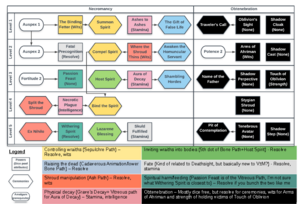Oblivion: Difference between revisions
Jump to navigation Jump to searchm (→CEREMONIES) |
(Alphabetized powers.) |
||
| Line 679: | Line 679: | ||
'''Process:''' After applying the concoction to the corpse or corpses and performing the Ceremony, the affected bodies animate into a form of false life. They follow a single command from the vampire, providing | '''Process:''' After applying the concoction to the corpse or corpses and performing the Ceremony, the affected bodies animate into a form of false life. They follow a single simple command from the vampire, providing the corpse is physically capable of performing it, such as “sweep the floor,” “hold this door shut,” or “walk around the house perimeter.” They have no ability to think or calculate, so conditional or complicated commands such as “attack the next person to walk through this archway,” “drive this car,” or “build a shack” do not work. They may be directed towards a specific target for attack or other action if the user points at the target. | ||
'''System:''' The | '''System:''' The vampire makes their Ceremony roll and upon a win they raise a number of corpses equal to their Oblivion rating, or the number of bodies they have prepared (whichever is lower). A critical win doubles their Oblivion rating for the purpose of determining corpses raised. The mindless corpse’s animation ends when it is destroyed or it concludes its task. These corpses do not defend themselves from attacks, and decay as normal; the Ceremony does not grant them any form of immunity to the elements or time. | ||
{| class="wikitable" | {| class="wikitable" | ||
| Line 692: | Line 692: | ||
<div style='text-align: right;'> | <div style='text-align: right;'> | ||
''<sub> | ''<sub>Players Guide, pg. 92</sub>'' | ||
</div></div> | </div></div> | ||
<br> | <br> | ||
== | == THE KNOWING STONE == | ||
<div class="toccolours mw-collapsible mw-collapsed" style="width:568px;"> | <div class="toccolours mw-collapsible mw-collapsed" style="width:568px;"> | ||
'''Oblivion''' • | '''Oblivion''' • | ||
'''Prerequisite:''' | '''Prerequisite:''' Oblivion's Sight | ||
''This Ceremony enables | ''This Ceremony enables Necromancers to identify the locations and existences of specific ghosts.'' | ||
'''Ingredients:''' | '''Ingredients:''' Stone from a church wall (or other holy site) and a cup of the caster’s vitae. | ||
'''Process:''' | '''Process:''' They pour it from their body into a vessel and then uses it to write out the true name of a deceased human on the consecrated stone. If the individual still exists as a ghost, their location becomes clear to the vampire. | ||
'''System:''' Roll Resolve + Oblivion (Difficulty 2). If the target exists as a ghost, the vampire receives a vision of the ghost’s location. The vision can be accessed for the remainder of the scene. | |||
'''System:''' | |||
<div style='text-align: right;'> | <div style='text-align: right;'> | ||
''<sub> | ''<sub>Fall of London, pg. 259</sub>'' | ||
</div></div> | </div></div> | ||
<br> | <br> | ||
== | == SUMMON SPIRIT == | ||
<div class="toccolours mw-collapsible mw-collapsed" style="width:568px;"> | <div class="toccolours mw-collapsible mw-collapsed" style="width:568px;"> | ||
'''Oblivion''' • | '''Oblivion''' • | ||
'''Prerequisite:''' | '''Prerequisite:''' The Binding Fetter | ||
''This Ceremony enables a vampire to summon a spirit from the Underworld.'' | |||
'' | '''Ingredients:''' One of the targeted wraith’s fetters (see The Binding Fetter, p. 85), a photo or other visual depiction of the wraith or their signed name, and the caster’s vitae. | ||
''' | '''Process:''' The necromancer pours their vitae over a wraith’s fetter, and studying the picture or signature, calls out the wraith’s name. The wraith feels their fetter’s call, and begins a journey from their location in the Underworld to that of the caster. Though geography has differing scales in the Underworld, a journey may still take several nights if the spirit is on the other side of the world. If the veil is thin enough in the summoning location, the wraith is pulled through the veil between worlds by the fetter’s strength. The summoned wraith is under no obligation to serve the vampire upon being called and may act with hostility if they feel the vampire is threatening their fetter. Alternatively, the wraith may be grateful for the summoning and the possibility of companionship. | ||
''' | '''System:''' The caster daubs the fetter with their vitae and makes an Oblivion Ceremony roll. The wraith cannot pass through the veil if it’s impenetrable in the Ceremony location (see p. 88). Moving the fetter after the Ceremony doesn’t help, as the wraith’s ability to pass through the veil disappears if the fetter leaves the Ceremony site. The wraith disappears at the end of the scene unless a separate Ceremony is used to compel or bind them. | ||
Wraiths summoned in this way do not manifest physically, but as shadows on the walls, quavering silhouettes of their living selves, from which voices might emerge. Wraiths speak the same languages they did in life, unless they’ve gone to the trouble of learning new ones in the Underworld. | |||
<div style='text-align: right;'> | <div style='text-align: right;'> | ||
''<sub> | ''<sub>Players Guide, pg. 92</sub>'' | ||
</div></div> | </div></div> | ||
<br> | <br> | ||
== | == TRAVELER'S CALL == | ||
<div class="toccolours mw-collapsible mw-collapsed" style="width:568px;"> | <div class="toccolours mw-collapsible mw-collapsed" style="width:568px;"> | ||
'''Oblivion''' • | '''Oblivion''' • | ||
| Line 755: | Line 755: | ||
''This Ceremony | ''This simple Ceremony is taught by the Cult of Shalim to all priests before their release into the wider world. Since all priests of Shalim are linked by their common bond with Apolleon the Traveler, they are able to use his presence in eternal Oblivion as a nexus between themselves and their followers.'' | ||
'''Ingredients:''' | '''Ingredients:''' The black book gifted to them following their indoctrination into the cult | ||
'''Process:''' | '''Process:''' By using the Traveler’s Call with their black book in hand and the name of another Shalimite in mind, a priest can send a ripple out across Oblivion, calling the target to their location. Unlike a true summoning, this power does not place a compulsion upon the victim, but does alert the Shalimite being contacted to the vampire’s current location through a repetitive, flashing vision of the scenery surrounding the calling Kindred. | ||
'''System:''' | '''System:''' The cultist must possess their black book and know the name of another Shalimite. The vampire’s player makes a Ceremony roll (Difficulty 3). The contacted vampire can choose to ignore the call, but the flashing vision gives them −2 dice to all rolls involving concentration for the remainder of the scene, at which point the call disappears. A critical win by the vampire allows them to send a single-word message to their point of contact along with the vision. | ||
<div style='text-align: right;'> | <div style='text-align: right;'> | ||
''<sub> | ''<sub>Cults of the Blood Gods, pg. 93</sub>'' | ||
</div></div> | </div></div> | ||
Revision as of 08:33, 3 April 2023
OBLIVION
Obtenebration | Necromancy | Abyss Mysticism | Mortis | Thanatosis
Oblivion is a mysterious, unpalatable power that most vampires rightly fear to use, witness, or fall victim to. Only vampires of Clans Lasombra and Hecata wield it with any frequency, and even they do so tentatively. Oblivion requires cautious masters who know the power’s risks, as no other Discipline reaches into the Underworld and allows its manipulator to extract tangible darkness or furious spectres. Oblivion is the darkest of arts.
Notably, while the Lasombra are prone to expanding their repertoire of Oblivion powers, the Hecata focus their energies on developing Ceremonies (see p. XX). Ceremonies take longer, but are required for communing with and making passage through to the lands of the dead.
CHARACTERISTICS
- Type: Mental
- Masquerade Threat: Medium-High.
Spirits and abyssal shadows rarely show up well on cameras but are obviously unnatural if witnessed in person.
- Blood Resonance: None.
Psychopaths and the emotionally detached. Blood empty of Resonance.
- Note: When making a Rouse check for an Oblivion power or Ceremony, a result of “1” or “10” results in a Stain, in addition to any Hunger gained. If the user’s Blood Potency allows for a re-roll on the Rouse check, they can pick either of the two results.
Oblivion allows for the manipulation of creatures and substances originating from the Underworld. When the Hecata use this Discipline, they tend to channel the entropic nature of the Underworld and its surroundings, decaying flesh, calling forth spirits, and posing a dangerous risk to the living.
Oblivion projections and spirits sustain damage from fire and sunlight, counting as vampires with Blood Potency 1 in this regard. They also take one level of Aggravated Health damage per round from bright, direct lights, and may also be damaged (Superficially or Aggravated) from blessed weapons and artifacts, depending on the strength of the blessing and whether the wielder has True Faith.
Oblivion’s powers are ineffective in brightly lit areas. Daylight and rooms without shadows are prohibitive, preventing the Discipline’s successful function, though ultraviolet light and infrared light place no restriction on the Discipline’s use. Moderately lit rooms apply a one-die penalty to the Discipline roll involved.
The use of Oblivion negatively affects the necromancer’s psyche, with many powers causing Stains as the vampire finds themselves performing increasingly macabre acts in service to this Discipline.
CEREMONIES
Unless otherwise noted, performing a Ceremony requires a Rouse Check, five minutes per level to cast, and a winning Resolve + Oblivion test (Difficulty = Ceremony level +1). Ceremonies usually require additional ingredients or sacrifices to mingle the caster’s vitae with. Unless otherwise stated the caster can only perform beneficial Ceremonies on themselves. Ghouls of Oblivion practitioners, or thin-bloods, can gain temporary access to Oblivion powers, but not to Ceremonies.
Ceremonies each have a prerequisite Oblivion power. At character creation a player can choose one Level 1 Ceremony if they have at least one Oblivion power noted as a prerequisite for that Ceremony. Characters can buy new Ceremonies at the cost of the Ceremony’s level x 3 experience points, providing they meet the power prerequisite as well. Learning new Ceremonies during play requires both experience and time, as well as a teacher who knows the Ceremony already. Expect a Ceremony to take at least the square of its rating in weeks to learn.
Note: Past and future products contain Oblivion Ceremonies and powers that may match well with those presented here. If these books are available, the Storyteller may feel free to suggest alternate prerequisite powers.

